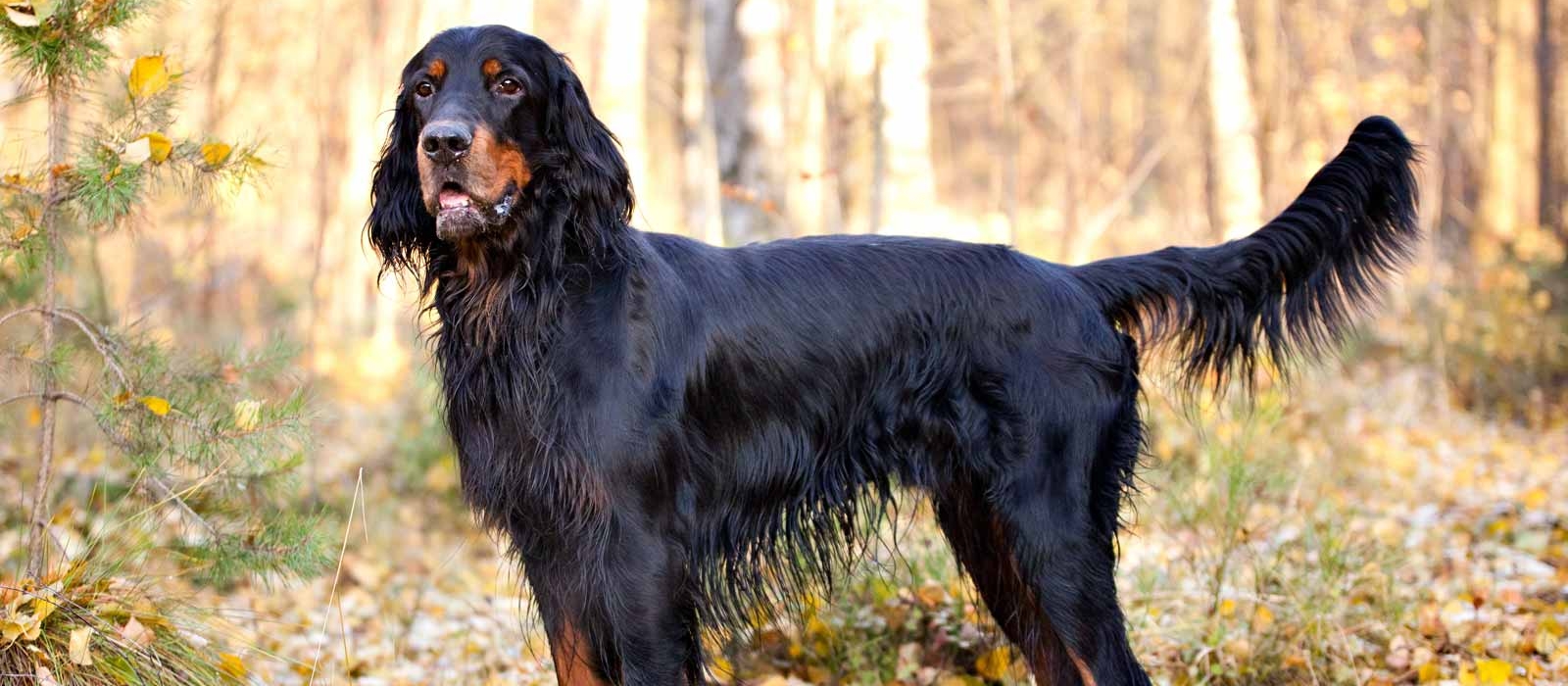-
Activity Level:
high
-
Shedding Level:
moderate
-
Grooming Level:
moderate
-
Trainability:
high
-
Good for Novice Owners:
moderate
-
Adaptability:
moderate
-
Kid/Pet Friendly:
often
-
Prey Drive:
high
-
Watchdog:
very alert
- Average Size: Medium
- Average Lifespan: 12-13 years
- Registered?: aca, akc, other
Gordon Setter Dog Breed Information
Overview
Temperament
Adaptability
Health
Owner Experience
Grooming
Activity Level
Size
Life Span
Did You Know?
One of the facts about Gordon Setters is that, although their ancient lines can be traced back to 1620, the Gordon Setter originated in Scotland over 200 years ago. The Fourth Duke of Gordon, Alexander Gordon, was a fan of setters and is credited as an important figure in the development of the Gordon Setter.
Not only did he found a kennel of “Black and Tan Setters” at his castle, but he was also responsible for crossing these original black and tan setters with Bloodhounds, black and tan Collies, solid-black setters, and black Pointers to create the Gordon Setter as we know it today.
These dogs were bred and trained to “set” when they found birds. This meant they would lay down quietly so the hunter would know where to cast a net to ensnare and flush out birds. Their heavy bone structure and square frame served them well in the craggy, challenging landscape common to the Scottish Highlands.
George Blunt, a man from New York, brought the first Gordon Setters to the United States in 1842. From there, the breed started taking hold. The British Kennel Club recognized them as a Black and Tan Setter in 1872.
By 1878, the breed was also registered in the United States with AKC recognition coming in 1884 as the Gordon Castle Setter. In 1892, the AKC changed the breed name to Gordon Setter. It wouldn’t be until 1924 that the Kennel Club (previously the British Kennel Club) would also update the name of the breed to Gordon Setter.
Gordons are focused, determined, and hardworking out in the field. At home with their families, they are affectionate, sweet, and loyal. They tend to be gentle, patient, playful, and sweet with children. This dog breed is also known for being a puppy at heart, much like the lovable Labrador Retriever, and takes a little bit more time to mature.
They may be aloof towards other dogs and strangers, but socialization early and often can help. Still, they tend to prefer attention from “their” people. They will gladly accept friendly pats and attention from strangers, but they don’t tend to actively seek it out as they would rather be near their humans and get attention from them.
The Gordon Setter is a moderately adaptable dog breed. Due to their high energy, they tend to be better suited to homes with yards where they can run. They can adapt to apartment living, but it can be a challenge to make sure they get the exercise they need to be happy and healthy. Because Gordons are so devoted to their families and bond so closely with them, they do not like to be left alone for long periods of time.
This dog breed does well in most climates. As with any dog breed, they are sensitive to heat and extreme cold. Because they were bred for the Scottish Highlands, they handle cold a little better than other dog breeds. But, they aren’t an Arctic dog breed, so you may need to bundle them up with some winter dog products if temperatures will be low while out on walks.
This is a relatively healthy dog breed. As with any dog breed, there are some potential health concerns to be aware of. For Gordon Setters, these potential concerns can include hip dysplasia, elbow dysplasia, and eye conditions. Good breeding practices and the health of the parents make a big difference in the health of Gordon Setter puppies.
Responsible breeders will test and screen their dogs to avoid passing preventable diseases or conditions on to puppies. So, don’t be afraid to ask them about the genetic and health history of the parents. You can also ask to see any relevant health clearances or test results.
The Gordon Setter Club of America, Inc. recommends a CHIC DNA repository, a DNA test for progressive retinal atrophy, specially rod-cone dysplasia (PRA-rcd4), an elbow evaluation, a hip evaluation, and an ophthalmologist evaluation.
As a large, barrel-chested dog breed, the Gordon Setter is at a higher risk of bloat. Bloat in dogs can become serious and quickly becomes fatal if gastric torsion occurs (i.e.; if the stomach flips). It’s important to know how to reduce the risk of bloat for your dog and what signs mean that you need to get to the emergency vet.
Although the Gordon Setter is highly intelligent and eager to please their owners, they also have a lot of energy and can also have a stubborn streak. And, because they pick up on things so quickly, they can get bored quickly as well. They are also happiest when they are with their families and have a job to do.
Gordon Setters may be considered highly trainable dogs, but these characteristics can be challenging for first-time dog owners to navigate alone. So, it’s a good idea to be prepared to enroll in puppy training classes. Regardless of owner experience, training classes can still be a good idea as they often offer opportunities to socialize a puppy.
The Gordon Setter will shed moderately year-round with heavier shedding sessions as the seasons change. Brushing weekly at a minimum is necessary to remove tangles and prevent matting. Brushing a few times a week can help prevent mats, control dog shedding, and minimize loose fur around the house.
This dog also requires monthly bathing as well as monthly trims of the fur on their feet and in between paw pads, in and around the ears, and around their rear and tail. You can handle this yourself at home or you can go to a professional groomer once a month for them to take care of it.
In addition to coat care, you will also need to care for your Gordon Setter’s nails, ears, and teeth. Cutting your dog’s nails once or twice monthly is usually enough to keep them from growing too long. But, if your Gordon is not wearing down their nails as much naturally via their activities or their nails just grow quickly, you’ll need to trim them more often.
Checking ears weekly and carefully cleaning your dog’s ears as needed can help prevent ear infections. This is especially important because Gordons have long, floppy ears that are more prone to ear infections because they are more likely to trap dirt, debris, and moisture.
Good dental care for dogs is also essential. Mostly due to a lack of consistent, good dental care, gum disease is one of the most common health issues in dogs. Using an enzyme toothpaste or brushing your dog’s teeth every day, along with cleanings at the vet when needed, is ideal for preventing painful dental diseases later in life. You can also work with your vet to supplement your efforts by creating a “dental care diet” for your dog and identifying good options for dental hygiene chews.
Gordons are high-energy dogs. They may be happy cuddling with you, but they still need plenty of exercise, mental stimulation, and affection to stay happy and healthy. Daily walks plus playtime, extra activity, and time to run are usually sufficient for this dog, but they will likely be up for more activity if you are.
They’ll often be happy just being active with you. So, don’t be afraid to try different activities and find your favorites. You can try teaching your dog to play frisbee or fetch. Once puppies are finished growing and bones are done developing, you can also take your Gordon Setter running or jogging with you.
They may also enjoy hiking with you, taking trips to the dog park, or even swimming! Gordon Setters also tend to be good candidates for dog sports like agility, obedience, tracking, flyball, field trials, and more. They’ll likely love spending time with you while being active and learning something new.
Just be careful about when you exercise them when you are near feeding times, especially when it comes to heavier or more intense activities. Try to avoid a lot of exercise or excitement at least half an hour before eating and at least one hour after eating as this can help reduce the risk of bloat.
Your vet can also work with you on more individualized guidelines and tips for your dog for reducing the risk of bloat, what exercises to avoid as puppies, clearing them for activities once they finish growing, and more.
A fully-grown Gordon Setter usually stands 23-27 inches tall at the shoulder and weighs 45-80 pounds. Females tend to average 23-26 inches tall and weigh 45-70 pounds while males tend to average 24-27 inches tall and weigh 55-80 pounds.
Gordon Setters generally live for 12-13 years on average.
The Gordon Setter is the largest and heaviest of the setters.






